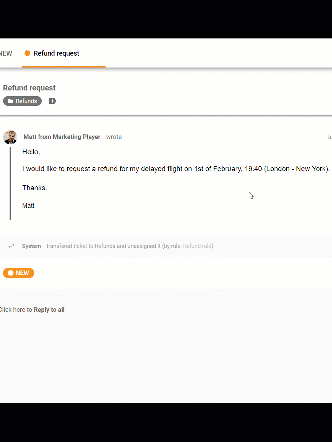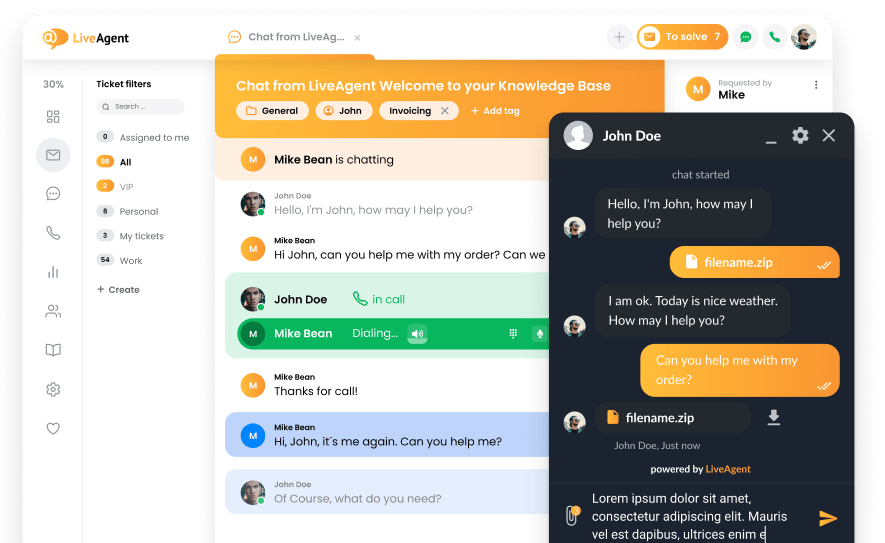- Email Templates
- Sales email templates
Sales email templates
Discover effective sales email templates offering up to 4400% ROI, ideal for businesses of all sizes. Email remains the top sales channel, preferred over social media, with templates for every occasion to boost sales and customer engagement.

Despite the rapid growth of social media and other digital marketing channels, email still remains the most powerful and the most efficient sales and marketing tool that outperforms any other channel. In fact, with a potential return on investment of up to 4400%, email marketing has proven to be the best way to attract and retain customers for both small scale businesses and large organizations. The following email marketing stats clearly demonstrate that the success of your sales efforts heavily depends on whether and how you are using email in your digital marketing strategy.

Why email remains the best sales channel
- 72% of people prefer to receive promotional content through email, compared to 17% who prefer social media.
- 61% of consumers prefer to be contacted by brands through email.
- 90% of email gets delivered to the intended recipient’s inbox, whereas only 2% of your Facebook fans see your posts in their News Feed.
- Your message is 5x more likely to be seen through email than Facebook.
- You are 6x more likely to get a click-through from an email campaign than you are from a Tweet.
- When it comes to purchases made as a result of receiving a marketing message, email has the highest conversion rate (66%), when compared to social, direct mail, and other channels.
- 4.24% of visitors from email marketing buy something compared to 2.49% of visitors from search engines and 0.59% from social media.
- The average order value of customers from email is at least three times higher than that of social media.
- Globally, 30% of marketers cite email marketing as having the highest ROI.
10 email templates for your sales and marketing team
Using ready-made email templates can make your work easier and increase your performance. Here are 10 basic sales email templates you can tweak for your industry, product, customer, or prospect.
From cold prospecting and follow-ups to engaging your existing customer base with different types of promotional emails – these templates can be a great starting point for your own help desk email marketing campaigns and outbound sales communications. For formal communications such as product launches or announcements, using a press release example template can ensure you convey your message professionally.
Inbound lead email
Hi [NAME],
You recently visited our website and [action took on website]. I was wondering whether you were trying to figure out how you might [business solution]?
This inspired me to spend a few minutes on your site to gain a better understanding of how [Company] can help you [achieve specific goals].
We are working with similar companies in your industry, helping them [accomplish …]. Would it make sense to talk for 10 minutes this week? Please also feel free to book time directly onto my calendar here: [link].
Hope to hear from you,
[YOUR SIGNATURE]
Sales introduction email
Hi [NAME],
I checked out your website, and it looks like you might be trying to [accomplish specific goals]. If you’re unfamiliar with [Company], we are working with similar companies in your industry, such as [competition], helping them accomplish three major goals:
[Goal #1]
[Goal #2]
[Goal #3]
If this is something you’re challenged with too, l would love to introduce you to [Product] to see if it meets your requirements. Would you have 10 minutes this week for a Zoom call?
Best,
[YOUR SIGNATURE]
P.S. If you’re not the right person to speak with, who do you recommend I talk to?
Prospect follow up email
Hi [NAME],
Hope all is well. I trust that you have had an opportunity to read my previous email and look at our website, so I figured it’d be worth checking in with you again.
Have you given any additional thought to our proposal? I’d be happy to do a quick review of it on the phone and answer any questions you may have.
If it makes sense to talk, please let me know how your calendar looks. If not, who is the appropriate person for me to talk to?
Look forward to hearing from you,
[YOUR SIGNATURE]
New product launch email
Hey [NAME],
We’re thrilled to let you know that [Company] has just launched our new [Product name]!
In the last few months, we’ve been tirelessly working to make it valuable for our customers and we believe that [Product name] will help you enjoy your experience with [Company] even more.
If you’ve been struggling with [Issues this product solves], [Product name] would be a big help. If you’re interested in learning more about it, feel free to reach out. You can also find out more about it on our website here: [link].
Let us know if you have any questions or want to talk more.
Thanks!
[YOUR SIGNATURE]
Loyalty program email
Hey [NAME],
We’re excited to announce the launch of our new [Name of loyalty program]. We’ve created lots of exciting and exclusive rewards to say thank you to our amazing customers, like you!
Earn 1 point for every $ you spend [online and/or in-store] to unlock exclusive rewards.
[Reward Title 1] – [100] points to redeem
[Reward Title 2] – [200] points to redeem
[Reward Title 3] – [300] points to redeem
There are also lots of other ways to earn loyalty points with us. You can earn points for [joining / completing your profile/ following us on social media/ referring friends, etc.].
Join Our Loyalty Program/ Learn More
[YOUR SIGNATURE]
Upsell email
Hi [NAME],
I hope your [year] is off to a great start!
We noticed that you’ve been paying for a monthly [Product/Service] subscription, and we’re grateful to be able to help you [accomplish your business goals]. I’m writing today with a small tip on how you can get the same set of features at a lower price.
By switching to annual billing, you’ll bring your monthly costs down from $ X to $ Y. There’s no lock-in contract or any obligations. If you decide to switch back or cancel your subscription at any point, we’ll be happy to refund you for any unused time.
Switch to Annual Billing and Save X %
If you have any questions or need any help at all, don’t hesitate to reach out.
Regards,
[YOUR SIGNATURE]
Upgrade offer email
Hi [NAME],
As a valued [Company] customer, you’re invited to enjoy a free, one-month upgrade to [Product] Premium. Activate your free upgrade with no risk, no commitment, and no credit card input. With [Product] Premium, you can:
Benefit 1
Benefit 2
Benefit 3
And much more!
Upgrade to Premium Now
Your account will be upgraded instantly, and you’ll enjoy full access to premium features for a full month. Join thousands of users who have discovered the difference [Product] Premium makes to their [business/ daily productivity, etc.].
Best regards,
[YOUR SIGNATURE]
Customer birthday offer email
Dear [NAME],
It’s your birthday today! Celebrate with a little extra something on us.
As a small birthday treat, we are giving you 50% off your next purchase for the rest of the month. Make sure to enter your unique code below at checkout. But hurry – it’s only valid till the end of the month!
DISCOUNT CODE
Best wishes from all of us at [Company]!
[YOUR SIGNATURE]
Holiday offer email
Hi [NAME],
The holidays are fast approaching and will be here before you know it! At [Company], we’ve got something for everyone this year. Get your holiday list in check and take advantage of our incredible deals this week:
Shop our Holiday deals here
Bonus: Spend $XX or more on [products] and receive a FREE [product] as a gift with your purchase!
Happy holidays!
[YOUR SIGNATURE]
Black Friday promo email
Hey, [NAME]!
Are you as excited as we are for Black Friday?
To celebrate the holidays and eating turkey, we’re running our biggest sale yet. Starting at midnight Thanksgiving day, we’re opening up 50% OFF our hottest products!
Hurry, the sale ends Sunday at midnight. Keep in mind that stock is limited and it’s on a first-come, first-served basis!
Grab the Offers
Don’t want to miss out? Click here to join our special Black Friday email list to be among the first to get notified when our sales happen (and when stock is getting low).
Until then, wishing you a happy Thanksgiving!
Cheers,
[YOUR SIGNATURE]
Ready to put our sales templates to use?
LiveAgent is the most reviewed and #1 rated help desk software for small to medium-sized businesses. Try it today with our free 30-day trial. No credit card required.
Frequently Asked Questions
How do you write a sales proposal email?
Writing a sales proposal requires careful consideration of the recipient's needs, the product or service being offered, and the overall tone of the email. Clearly outline the problem that your product/service can address, and emphasize the benefits and value it can provide. Give details and examples to support your claims, and include any relevant data or testimonials to build credibility. Be sure to include a clear call to action and make it easy for the recipient to respond or take the next step.
How do you follow up with customers after sales?
Following up with customers after sales can be done through various methods. You can send a personalized thank-you email, make a brief phone call to ensure their satisfaction with your products/services, or send a post-purchase survey for feedback. The main goal is to show appreciation, address any potential concerns, and foster a long-term relationship and loyalty.
How do you write a sales email?
You can approach writing sales emails in numerous ways. The most important thing is to understand your customer’s needs and tailor your message to fit them. The rest will follow.
How do you write a sales target email?
For each new customer, you will need to write a new email that includes a personal greeting, an overview of the product or service, a sales goal, and a call to action.
How do you end a sales email?
You can end a sales email with a call to action that offers the recipient a product or service.
You will be
in Good Hands!
Join our community of happy clients and provide excellent customer support with LiveAgent.

Our website uses cookies. By continuing we assume your permission to deploy cookies as detailed in our privacy and cookies policy.

 Български
Български  Čeština
Čeština  Dansk
Dansk  Deutsch
Deutsch  Eesti
Eesti  Español
Español  Français
Français  Ελληνικα
Ελληνικα  Hrvatski
Hrvatski  Italiano
Italiano  Latviešu
Latviešu  Lietuviškai
Lietuviškai  Magyar
Magyar  Nederlands
Nederlands  Norsk bokmål
Norsk bokmål  Polski
Polski  Română
Română  Русский
Русский  Slovenčina
Slovenčina  Slovenščina
Slovenščina  简体中文
简体中文  Tagalog
Tagalog  Tiếng Việt
Tiếng Việt  العربية
العربية  Português
Português 


